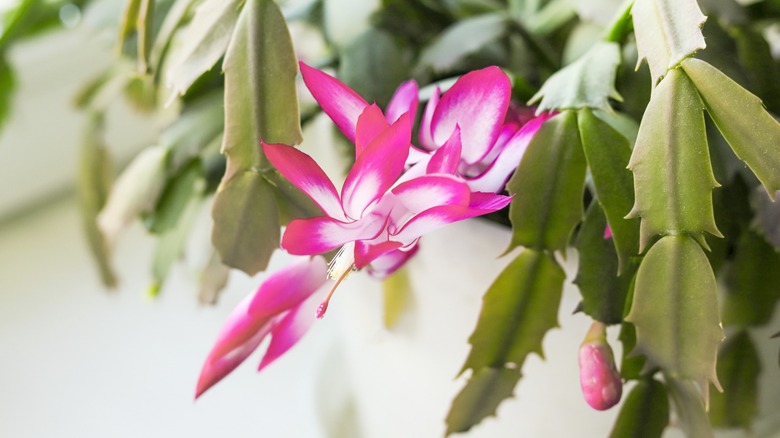Are Your Christmas Cactus' Leaves Discolored? Here Are Some Causes And Solutions
We may receive a commission on purchases made from links.
If you've ever had the chance to admire the bright blooms of a Christmas cactus, then you understand how gratifying it is to observe your own plants blossom. But what do we do when those lovely flat green leaves begin to fade? Discoloration of Christmas cactus leaves can be a common concern among plant owners. When these leaves begin to turn yellow, red, gray, or even brown, it typically indicates an underlying issue. However, losing color doesn't necessarily spell death for your plant. Usually, the cause is environmental or related to care.
An ailing Christmas cactus will show signs of distress in many ways, and a leaf color change is usually one of the first indicators. Mistakes with plant watering, lighting, temperature, and nutrient levels are the most common and likely causes of leaf discoloration. Determining why your plant is discolored is the first step to rectifying the problem and getting your plant back in business. Often, Christmas cacti are quite hardy and can rebound if given proper care. Let's look further at some deadly mistakes to avoid making with your Christmas cactus, the possible causes of leaf discoloration, and some useful solutions that can bring your plant back to its former glory.
Common causes of discolored Christmas cactus leaves
Overwatering is one of the most common reasons for Christmas cactus leaves to discolor. This plant needs well-draining, coarse potting mix, and its roots are very sensitive to standing water. If the roots remain wet for too long, they can start to rot, resulting in yellow or soft, mushy leaves. Similarly, not enough water can also impact the plant. If it isn't getting enough moisture, its leaves will start to suffer, shriveling up and looking stressed, along with becoming brittle, yellowing, or browning.
Another explanation could be light stress. Consider where your Christmas cactus is placed, as they thrive in bright, indirect light. If your cactus is exposed to too much direct sunlight, it may get sunburned, which will result in yellow or red discoloration. However, lack of light can also lead to a loss of the vibrant green coloring in the leaves as the plant struggles to photosynthesize. If your cactus is turning red, this can occasionally be an indication that it is actually getting too much light, particularly during the winter months when the plant is entering its bloom cycle.
Temperature stress is another contributing factor. Christmas cacti like it between 60 and 70 degrees Fahrenheit, and wide swings in temperature can make the leaves turn color. If your plant is located near a heater, air conditioner, or drafty window, it may be subjected to situations that interrupt its natural cycle of growth. Likewise, excessive humidity or not enough humidity will stress the plant out, and its leaves will discolor.
Solutions to restore your Christmas cactus
To combat leaf discoloration, first consider your watering habits. Make sure that your cactus is planted in a well-draining pot and that the soil isn't holding too much moisture. Water only when the top inch of soil is dry to the touch, and ensure that any extra water drains freely to prevent root rot. If you want to save your beautiful Christmas cactus from root rot, you can carefully take it out of its pot, cut rotten roots, and re-pot it with new, dry soil.
If light stress is a problem, move your cactus to an area with bright, indirect light. Do not put it in direct sun, which can scorch the leaves. Generally, a north or east-facing window is best, but be aware of how the strength of the light changes seasonally. You might have to reposition the plant in the winter months or hang a partially transparent curtain. For temperature problems, place your cactus in a stable environment, free of drafts or warm sources that might cause temperature variation. Don't position it by cold windows in wintertime.
Also, monitor the humidity around the cactus: If the air is too dry, mist the plant sometimes or provide a humidity tray. Too-humid air is also an issue, so make sure the space is well-ventilated to avoid mold and fungus growth. If nutrients are throwing the plant out of balance, Epsom salt could be the secret to a flourishing Christmas cactus. Christmas cacti don't need heavy feeding, but a bit of Epsom salt can encourage healthy growth and prevent discoloration due to nutrient deficiencies during the growing season (spring and summer). You can buy Amazon Basics Epsom salt on Amazon.


